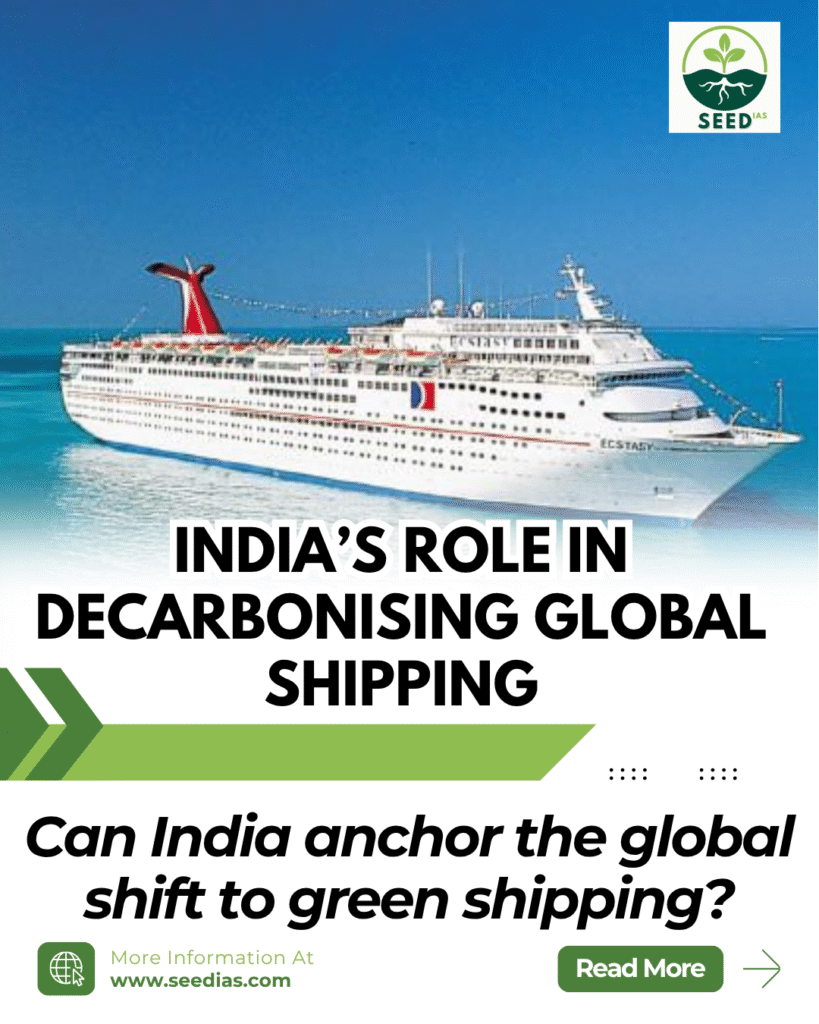Why in NEWS
Global shipping is on course to slash its carbon emissions drastically by 2040–2050 due to climate imperatives and international decarbonisation goals. This presents a key opportunity for India to become a global hub for green fuel production and shipping infrastructure.
Key Concepts/Terms
| Term | Meaning |
|---|---|
| VLSFO | Very Low Sulphur Fuel Oil – a conventional marine fuel with reduced sulfur content |
| Green Methanol | Produced using green hydrogen and captured CO₂ from industrial processes |
| Green Ammonia | Created from green hydrogen and nitrogen from air; carbon-neutral fuel |
| IMO (International Maritime Organization) | UN body regulating international shipping, aiming for net-zero emissions by 2050 |
| MBM (Market-Based Measure) | Economic tools to reduce shipping emissions by rewarding low-carbon practices |
| GHG Intensity | Greenhouse Gas emitted per unit of energy produced or used |
Key Points
| Aspect | Details |
|---|---|
| Current Emissions Status | Shipping emits nearly 3% of global GHG emissions; if untreated, it may rise by 250% by 2050 |
| IMO Goals | Reduce carbon intensity by 40% (2030), 70% (2040), and achieve net-zero (2050) |
| India’s Key Role | Hosted Green Shipping Conclave 2025, advocated MBM at IMO MEPC-83 |
| India’s Green Fuel Mission | National Green Hydrogen Mission aims at global green hydrogen leadership |
| Green Ports & Bunkering | Harit Sagar Guidelines, Green Tug Transition Programme, and green fuel-ready ports at Kandla and Tuticorin |
| Maritime Development Fund | ₹25,000 crore for green infrastructure and fleet upgrades |
| Export Edge | Indian green hydrogen meets IMO carbon thresholds, boosting export potential |
| Tech Partnerships | Collaboration with Japan, South Korea, and Singapore for tech transfer and global reach |
In a nutshell
India’s Green Voyage
Mnemonic: SAIL GREEN
- S – Solar-powered hydrogen hubs
- A – Ammonia & Methanol production
- I – IMO-aligned policies
- L – Local shipbuilding & retrofitting
- G – Green port infrastructure
- R – Reward-driven MBM frameworks
- E – Export-oriented green fuel policies
- E – Electrolyser manufacturing push
- N – Net-zero vision by 2070
Prelims Questions
- Which of the following fuels is carbon-neutral and derived from green hydrogen and atmospheric nitrogen?
a) Biofuel
b) Green Methanol
c) Green Ammonia
d) VLSFO - Consider the following statements regarding India’s role in maritime decarbonisation:
- India proposed the MBM framework at IMO MEPC-83.
- Green Methanol can be used in existing ship engines with minor modifications.
- India’s National Hydrogen Mission targets green hydrogen export aligning with IMO standards.
Which of the above is/are correct?
a) 1 and 2 only
b) 2 and 3 only
c) 1 and 3 only
d) 1, 2 and 3
- Match the following green fuels with their respective challenges:
A. Green Methanol – 1. Volatile and needs special storage
B. Green Ammonia – 2. Competes with food production
C. Biofuel – 3. High cost due to renewable electricity
Options:
a) A-3, B-1, C-2
b) A-2, B-3, C-1
c) A-1, B-2, C-3
d) A-3, B-2, C-1
Mains Questions
- Discuss India’s policy and technological initiatives to decarbonise the global shipping industry. In what ways can India benefit economically from this green transition? 10 Marks
- (UPSC GS3 – Environment, 2021) “The global push for carbon neutrality has transformed energy geopolitics.” In this context, analyse the implications of India’s National Green Hydrogen Mission on the maritime sector. 10 Marks
Answers with Explanations
| Question No. | Correct Answer | Explanation |
|---|---|---|
| 1 | c) Green Ammonia | It is carbon-neutral and made from green hydrogen + nitrogen from air |
| 2 | d) 1, 2 and 3 | All statements are correct based on India’s recent policy actions and fuel properties |
| 3 | a) A-3, B-1, C-2 | Green methanol is costly, ammonia is volatile, biofuel faces land/food competition |
















